1. Introduction
Following the appeal for sightings of white tip disease (Phoma macrostoma) on Californian thistle (Cirsium arvense) in previous editions of the FFC Bulletin (2013-V2), a number of farmers and growers contacted the FFC asking about other non-chemical control methods for Californian thistle. This article explains some less well known means of non-chemically controlling Californian thistle that farmers and growers can implement themselves.
Globally, most non-chemical control techniques are based around defoliation of the aerial parts of the thistle during the growing (summer) season, using mowing and/or surface / shallow tillage. While these techniques can be effective against Californian thistle, they are not a silver bullet, as it typically takes three years to achieve a significant, e.g., 90% reduction of thistle biomass. As complete elimination of plants can take several more years, it is clear that defoliation is a long row to hoe, albeit a reliable one. However, there are other techniques that can be added to or substituted for a mechanical defoliation regime to enhance Californian thistle control, one of which does approach silver bullet status, at least for flat to undulating land where tractors can operate effectively. First however, to know how to effectively deal with any weed or pest in agriculture you need to understand and think like the enemy.
2. Thinking like the enemy: the biology of Californian thistle
Californian thistle is unlike all the other thistles in New Zealand which are annuals or biennials, as it is a perennial that can live for decades and theoretically it is just about immortal as it is a creeping weed that spreads via its root system, so it is constantly regenerating. A patch of Californian thistle in a paddock is in fact one individual cloned plant, connected underground by the spreading roots that grow horizontally through the soil, and which also act as the food storage system that allows the plant to remain dormant through the winter. Figure 1 shows patches of Californian thistle in a recently cultivated field. Individual clones can achieve considerable size with diameters of 10 to 20 meters possible.
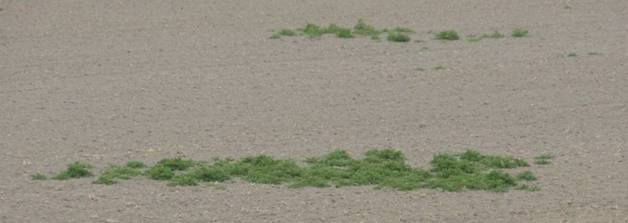
Figure 1. Californian thistle patches, each of which are individual cloned plants.
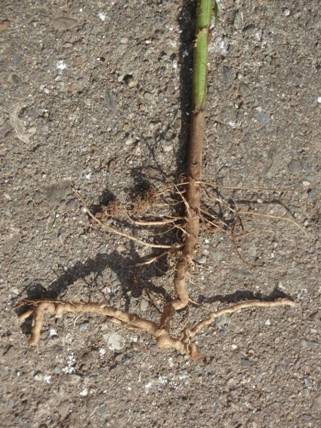
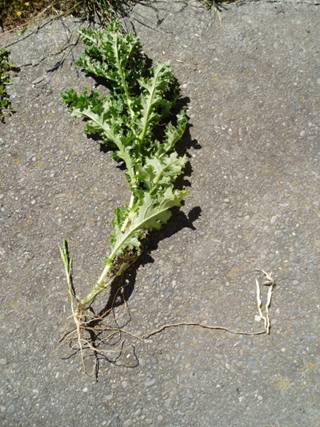
Figure 2. Left, Californian thistle spreading root and a vertical stem. Right, four month old plant originating from seed that has already produced the first horizontal spreading root along with a vertical shoot.
Another way to think of the structure of Californian thistle is that of a tree, with the individual thistle stems that grow out of the ground akin to leaves on a tree and the underground spreading roots as the trunk that connects all the branches that hold the leaves. This analogy illustrates the fact that it is the underground spreading roots that are the ‘heart’ of the Californian thistle plant, and that the above ground shoots are more ephemeral and expendable, like the leaves on a tree.
The spreading roots grow horizontally, between about 15 and 30 cm deep (Figure 2), depending on soil type, soil structure, tillage approach (e.g. ploughing vs. min-till or no-till) and production system (e.g. pasture vs. cropping), though in very loose soil they can be deeper still. The plants also produce ‘normal’ roots, i.e. that grow downwards and are not thickened, which have the normal root functions of taking up water and nutrients. These roots can penetrate to a considerable depth, e.g. a meter or more, the same as many other weeds and crop plants, however, they don’t have the same regenerative ability of the spreading roots.
As shown in Figure 2, the Californian thistle stems arise from the spreading roots. A side root from the main spreading root starts to grow upwards and then transforms from a true root to a true shoot, with the boundary between root and shoot delimited by the end of the small feeder roots emerging from the true root.
2.1. Californian thistle’s ‘life strategy’
The annual lifecycle of Californian thistle, is akin to a deciduous tree: in spring, like new leaves on a tree, new stems emerge from the soil, in summer the plant flowers and in the autumn produces seeds before the above ground parts die back for winter, often following a good frost, like the leaves falling from the trees. The plant then remains dormant over winter, existing only as the underground root system, until spring when the cycle repeats.
In comparison, reproduction by seed is generally considered to be a much lower level strategy for Californian thistle. This is not to say that Californian thistle’s cannot produce a large amount of seed, and that seeds can’t survive in the soil for a number of years, even decades, however, and especially compared with annual weeds such as the infamous fat hen (Chenopodium album), it is very uncommon to find Californian thistle seedlings, even where there are large patches of thistles nearby. In my 20 years of farming and agricultural research experience in the UK, Ireland and New Zealand, I have only positively identified a couple of handfuls of Californian thistle seedlings on working farms, even those that have Californian thistle problems. In comparison, I must of seen billions of fat hen seedlings over that same time, with some fields producing thousands of seedlings per square meter.
However, this is not to say that Californian thistle’s reproduction by seed should not be ignored entirely: I know of one farm that took a home-saved crop of barley seed from a field with Californian thistle that had gone to seed, and through inadequate seed cleaning, planted a load of thistle seed heads with the barley, and turned a clean field into one full of Californian thistle. Interestingly, over 10 ha, there were only a few tens of thistle patches i.e. individual clones (although very large ones) indicating that the number of planted seeds that resulted in mature patches was again very small. This is in part explained by the slow early growth and poor competitive ability of Californian thistle seedlings.
The ‘life strategy’ of Californian thistle is therefore all about growing the spreading root system. The rate of growth of the roots and therefore individual plants can be quite profound: under ideal conditions of good soil, warm weather and most importantly, the absence of other plants, i.e. crops or pasture, individual seedlings can produce plants 10 meters across in a couple of years. Even very small lengths of root, such as 3 cm long, are able to regenerate and create new plants, again emphasising that the roots are the heart of Californian thistle.
A final point are the soil conditions that appear to favour Californian thistle. It is clear that Californian thistle favours some soil conditions over others, for example, the lack of Californian thistle across wide areas of farmland where the climate is amenable for the plants, while in similar climatic areas Californian thistle is the number one weed. Also within individual farms with a range of soil conditions, Californian thistle thrives in some areas but not others. Figure 3 shows a strip of Californian thistle that has been growing in an old stream bed, on the Canterbury plains, for over two decades, but that has never grown up and out of the stream bed into the rest of the field.
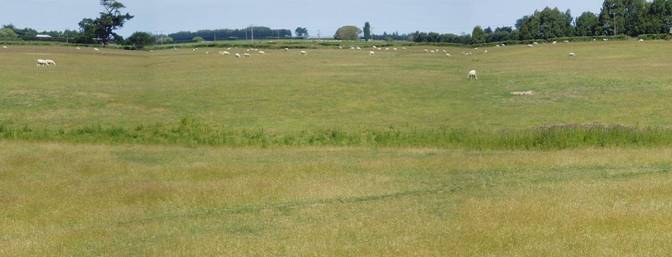
Figure 3. Californian thistle that has been growing in an old stream bed between Springston and Leeston on the Canterbury plains for two decades but that has not invaded the rest of the field over all that time.
Unfortunately, little research has been undertaken to accurately and reliably determine what soil conditions favour Californian thistle. The relationship between soil conditions and weed flora is also an area of much pseudoscience so should be treated with considerable caution. However, observations indicate that Californian thistle prefers moister soils, i.e. heavier soils that contain moderate and higher proportions of clay, and also some chalk and limestone derived soils that also tend to be heavy with a high water holding capacity. Dry soils, i.e. with moderate to high levels of sand, do not appear to allow Californian thistle to thrive. If this is correct, it is also likely that soil damage, such as compaction and cultivation / tillage pans that increase soil moisture, may well also favour Californian thistle. However, due to the lack of detailed research these observations should be taken as an indication not proof.
2.2. It’s the roots, stupid! (apologies to Bill Clinton)
So with Californian thistle’s life strategy focused on expanding the spreading root system and having a minor (but not zero) focus on reproduction and spread via seed, not only should the root system be the focus to kill existing plants, killing existing plants should be the dominant focus of a whole-of-farm Californian thistle management strategy. This because unlike the annual and biennial weeds where it is the seeds that are the fundamental life stage and the means of perennating from year to year and decade to decade, for Californian thistle its spreading root system is the means of reproduction, spread and perennation. That is why ‘it’s the roots, stupid’. If all Californian thistle plants are eliminated from a farm, and the few new plants that arise from seed, are rapidly dispatched, then Californian thistle will no longer be a problem. This is also why I consider Californian thistle to be a zero tolerance weed, because once eliminated, management is relatively easy and cheap, while just trying to keep a lid on the problem is a Sisyphean task.
3. Killing Californian thistle plants
However, while its easy to say that the best means of controlling Californian thistle is to kill all the plants, the reason Californian thistle is such a problem on so many farms, is the things are B. difficult to kill! Clearly some tools to break this circular problem are needed.
3.1. Crushing Californian thistles to death
Of all the non-chemical management tools for Californian thistle one stands head and shoulders above the rest in terms of potentially achieving an instant kill: subsoiling / deep ripping. This is one of those tools that is known of and being used by a small number of farmers, but one that has apparently completely bypassed the scientific establishment. Figure 4 shows a field which was wall-to-wall with Californian thistle the previous year. In the autumn the field was subsoiled to kill the thistle, however, the driver did not match the bouts up correctly so there were strips of ground that were not subsoiled between the subsoiled bouts. This accidentally made for a great experiment, in that the parts that were subsoiled were almost completely clear of Californian thistle, while the strips of field that were missed, show up as long thin strips of nearly solid thistle, which is now going to seed among the linseed crop.
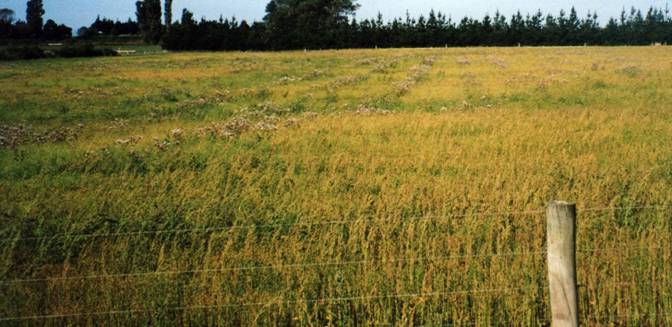
Figure 4. Narrow strips of Californian thistle (gone to seed) between wider thistle free strips following subsoiling with insufficient bout overlap in a linseed crop (with fathen).
While there is positive farmer and grower experience of the effectiveness of subsoiling for killing Californian thistle, the lack of scientific research is a concern because the exact mechanism by which subsoiling works has not been determined. The working hypothesis, is that the pressure created by subsoiling crushes the spreading root system, effectively to a pulp, thereby instantly killing the plant. What is not considered to be the cause is the subsoiling ‘merely’ breaking up the spreading root system into small fragments, while leaving the individual root section intact, because there is extensive scientific and practical evidence that shows fragmented but still living roots have remarkable regenerative capacity, and, if that were all that was occurring during subsoiling, then what were individual plants before subsoiling, would end up being a much larger number of smaller plants afterwards, somewhat like Goethe’s sorcerers apprentice who cuts the broom in half with an axe, only to end up with two brooms doing twice the work!
If this hypothesis is correct, it indicates that the subsoiling must be done in such a way that all the spreading root system is crushed. As the spreading root system is typically 15 to 30 cm deep, best practice subsoiling for compaction remediation may not be sufficient to achieve this. Figure 5 shows the key subsoiling issues relating to killing Californian thistle’s spreading roots.
- First the larger size of shatter cone, both at the surface and at depth from a winged subsoiler compared with a standard / traditional chisel point subsoiler. It is now generally regarded that winged subsoilers are superior to chisel points on a wider number of factors (see Figure 6 for examples of chisel and winged subsoilers).
- Best practice for the spacing between subsoiler legs is that the shatter cones should meet at the soil surface (therefore the deeper the ripping, the wider the leg spacing).
- Best practice leg spacing for compaction remediation, is however, insufficient to completely crush the spreading root system of Californian thistle as it is typically 15-30 cm deep in the soil, so not all of the root system will be within a shatter cone.
- Either, closer leg spacing (which will require legs to be offset longitudinally to avoid excessive draft) or better, undertaking a second pass of the subsoiler with the bout position offset by half the distance between legs, so that all of the spreading root system is within a shatter cone and therefore crushed to death.
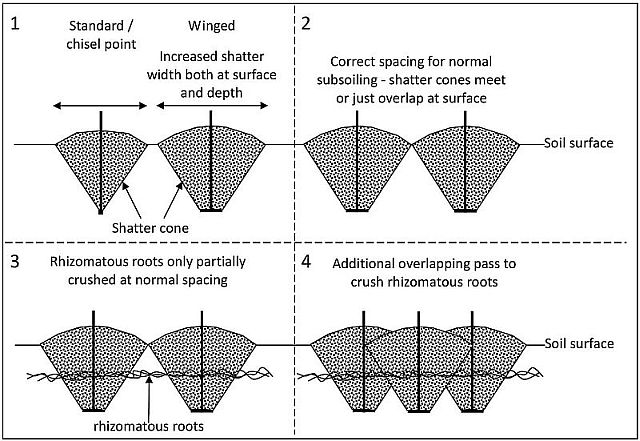
Figure 5. Diagram of subsoiling issues relating to killing Californian thistle spreading root systems. Section 1: increased width of shatter cone from winged vs. standard chisel point subsoilers. Section 2: Standard recommendation for correct spacing between legs. Section 3: the standard spacing for subsoiling, leaves some of the spreading roots unaffected / un-killed by the shatter cone so they will survive. Section 4: decreasing the spacing between legs, or better using overlapping bouts offset by half the distance between legs, results in all of the spreading roots being crushed within a shatter cone.
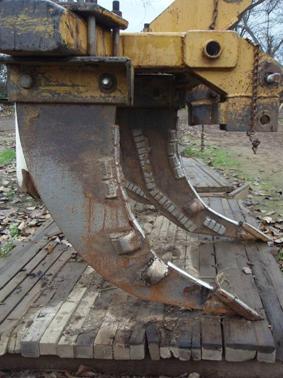
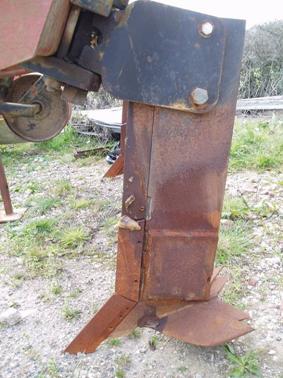
Figure 6. Standard chisel point subsoiler (left) winged subsoiler (right).
All of the above also requires that subsoiling / deep ripping is done correctly. Unfortunately, there are many cases where it is done badly with more harm than good being done. The key failure is subsoiling at incorrect soil moistures. Soils must be sufficiently dry, to the full depth of subsoiling, that they are no longer plastic, because if they are plastic they will deform not shatter. Equally, soils must not be so dry, that they no longer shatter into small crumbs, but break into large blocks. The only way to confirm if conditions are correct, and a good shatter to depth is achieved is by digging a soil pit after the subsoiler has passed. It cannot be over-emphasises the importance of doing the job right, and the key reference for this is Davies, Eagle and Finney’s classic text “Soil Management” now rebranded for the 6th edition as “Resource Management: Soil”[1].
If done correctly, farmer and grower experience is that Californian thistle can be completely killed in one operation. If some thistles regrow after treatment, it is important to re-subsoil them as soon as soil conditions are correct, and/or use other means to combat the regrowth.
In addition, if the common belief that Californian thistle like moist soil conditions is correct, subsoiling has the additional advantage of breaking up compaction and plough pans that can increase soil moisture, especially at depth where the spreading roots grow, thereby drying out the soil at depth and making the conditions less hospitable for Californian thistle’s spreading root system.
3.2. Goats
Sheep and cattle generally avoid grazing Californian thistle unless pushed hard or when the plants young and tender. Goats however will graze Californian thistle move avidly than sheep and cattle so they can be used as part of a Californian thistle management strategy, and they clearly have the edge over mowing in steeper terrain. However, goats, like other means of defoliation are no silver bullet, and they need the correct management to get the best weed control effect. For example, if there are other more palatable fodder species available, goats will graze those in preference. Goats won’t clear Californian thistle overnight, as the control mechanism is the same as mowing, i.e. exhausting the underground reserves, so it will take several years to eliminate Californian thistle under intensive grazing pressure, and longer under more infrequent / lower pressure.
Goats will also graze other thistles and are quite partial to the flower heads, but, it is important to manage grazing so that thistles don’t go to seed as the seed will pass right through animals guts and therefore be spread in the manure. This especially important for annual and biennial thistles as for these species, the seed, not the root, is the fundamental stage of the lifecycle and only means of reproduction and spread.
Milking goats are not suitable, due to disease and parasite problems, and only meat goats are up to the task. However, the final plus for goats, is unlike mowing and subsoiling, if well managed, they will produce an income, rather than just burning diesel. One useful resource in NZ for information on meat goats is https://www.caprinexnz.com/
3.3. Mowing in the rain
Another example of where science has been behind practical farmer and grower experience is mowing Californian thistles in the rain (without any assistance from Gene Kelly). This originated from farmer and grower observations that when mown in the rain, compared with dry conditions, the thistles were set back more. This was then tested, using on-farm trials, by scientists at AgResearch and found to be correct, with up to 30% reduction in thistle biomass compared with mowing in the dry. The likely cause is that wet conditions allow for greater transfer and infection of a range of fungal diseases between the cut stems, when then go on to harm, and even kill the plants. AgResearch has more information on the technique PDF file and Video and general management info
3.4. Non-mowing, mowers: Combcut
While mowing Californian thistles is a well proven technique, the downside, especially in an era of rising fuel costs and climate change, is the energy required by toppers and especially flail mowers. For farms with major Californian and other thistle problems, more energy efficient means of cutting down thistles could be beneficial. One machine, reported on in the last issue of the Bulletin (2014-V1) that could well fit that need is the Combcut. While currently designed for three point linkage mounting, there is no reason, and with a bit of kiwi ingenuity, that towed versions could not be constructed with small on-board engines to power the brushes, for use behind quad bikes and farm utes. Considerably faster forward speeds than toppers and mulchers should be possible using Combcut, thereby also reducing field time and total costs.
3.5. Crop and pasture competition
Following the logic of the old adage that a ‘sheep’s worse enemy is another sheep’ a plants worse enemy is another plant because they are competing for soil and light resources. A wide range of research and farmer and grower experience indicates that Californian thistle grows much faster / larger in low or no competition situations and can struggle in high competition. However, when many people think about plant competition, they mostly think only of the above ground aspect, i.e. competition for light. However, root competition, underground and therefore out of sight and therefore often out of mind, can have as big, or even much bigger effect than above ground foliar competition. So, once again, its back to the roots. However, with the spreading roots of Californian thistle being several tens of centimetres down the soil profile, and the feeder roots deeper again, it indicates that shallow rooted species, especially pasture species, such as rye grass (Lolium perenne) and white clover (Trifolium repens) are going to be less competitive with Californian thistle below ground than deeper rooted pasture species as chicory (Cichorium intybus) and lucerne (Medicago sativa).
Chicory appears to have particular value: one trial looking at mixed species pastures found the plots that had chicory, had very low Californian thistle populations compared with neighbouring plots with high thistle populations that did not have chicory even seven years after the trial started [2]; In addition chicory is a host to the sclerotinia fungus that attacks Californian thistle and that has been researched as a bio/mycoherbicide. There are reports of pure chicory fields used for seed production succumbing to sclerotinia which also eradicated the Californian thistle present in the fields. These are clearly interesting observations that need following up with more investigative experiments.
Other farmers report considerable success using highly competitive green manures / cover crops, such as a mixture of triticale (× Triticosecale) or rye (Secale cereale) with a climbing legume such as vetch (Vicia sativa) during the time Californian thistle actively growing, i.e. over spring and summer. Some report dramatic reductions in Californian thistle numbers following such crops. Such vigorous cover crops may well be achieving such an effect through both root and shoot competition, and rye and triticale are known to be allelopathic which may possibly be adding to the suppressant effect. Again this is an area farmers are leading the research, and more experiments are needed to optimise such approaches.
Another key benefit of using plants to fight Californian thistle, is that doing so can yield a double dividend, in that such techniques, even in the absence of thistle, can increase profit, and, they don’t require fuel intensive tractor operations such as subsoiling and mowing, so can be much more financially attractive than getting the mower or cultivator out.
And, relating back to the potential for goats to control Californian thistle compared with sheep and cattle, where stock are avoiding thistles, but grazing the rest of the pasture species, this is giving Californian thistle a (significant) competitive advantage over the pasture, especially where there is tight grazing, than where the pasture is ungrazed. Research from the UK looking at Californian thistle management in highland and other biologically sensitive / traditional upland grazing areas, found that (somewhat counterintuitively) reducing grazing pressure in autumn, and thus allowing the pasture to grow up and compete more with the thistles produced a large reduction in thistle biomass the following year [3].
However, despite some initial positive research and farmer and grower experience in this area a lot more research is required to really maximise the potential of using pasture species, cover crops and other types of plant competition and to also dispel potential myths out there.
4. Conclusions
Californian thistle is a major problem weed for a wide range of producers, from growers, through cropping farmers, to stock farmers across a wide range of climates and land topographies in NZ and globally. With a growing realisation that chemical / herbicide control of weeds faces an increasingly uncertain future, the need for effective non-chemical management techniques continues to grow (see ‘Challenges for pest management‘ in New Zealand in this issue). While there are some well developed techniques, principally mowing and shallow tillage, that when used at the right times can achieve good management over several years, other less well know techniques, such as subsoiling, integrating goats into stocking systems, especially for country too steep for easy machinery access, mowing in the rain and fighting fire with fire by using ‘good’ plants to defeat Californian thistle, also have considerable potential, but many of these also need research to underpin them and refine them, to get the best bang for your buck (or doe!).
5. References
1. Davies, B., Finney, B., and Eagle, D., Resource Management: Soil. 2001, Tonbridge: Farming Press Books. ISBN 0-85236-559-4
2. Musgrave, D.J. and Daly, M.J. Assessment of the performance of non-ryegrass pasture mixtures. in Proceedings of the New Zealand Grassland Association. 2004.
3. Pywell, R.F., Hayes, M.J., Tallowin, J.B., Walker, K.J., Meek, W.R., Carvell, C., Warman, L.A., and Bullock, J.M., Minimizing environmental impacts of grassland weed management: can Cirsium arvense be controlled without herbicides? Grass and Forage Science, 2010. 65(2): p. 159-174.
